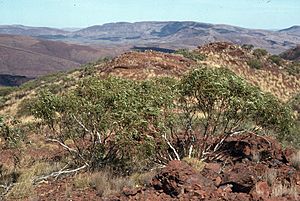Eucalyptus pilbarensis facts for kids
Quick facts for kids Eucalyptus pilbarensis |
|
|---|---|
 |
|
| Eucalyptus pilbarensis on Mt Nameless near Tom Price | |
| Scientific classification | |
| Genus: |
Eucalyptus
|
| Species: |
pilbarensis
|
The Eucalyptus pilbarensis is a special type of eucalypt tree or a small bush. It grows naturally only in the Pilbara area of Western Australia. This plant is easy to spot because of its smooth, often white or grey bark. It also has long, curved leaves, white flowers, and unique fruit that look like small cones or barrels.
What it Looks Like
The Eucalyptus pilbarensis is usually a mallee, which means it's a tree that grows many stems from the ground instead of just one main trunk. It can also be a low bush. This plant typically grows to be about 3 to 4 meters (10 to 13 feet) tall. It has a special woody swelling at its base called a lignotuber. This helps the plant regrow after fires or damage.
Its bark is very smooth and can be grey, whitish, or even a bit pink. When the plant is young, or when new shoots grow after being cut (called coppice regrowth), its leaves are a dull green. These young leaves are wide and shaped like a spear, about 5 to 8 centimeters (2 to 3 inches) long and 2 to 5 centimeters (0.8 to 2 inches) wide.
As the plant gets older, its leaves change. Adult leaves are shiny green on both sides and are shaped like a spear or slightly curved. They are usually 6 to 12 centimeters (2.4 to 4.7 inches) long and 1 to 2.2 centimeters (0.4 to 0.9 inches) wide. Each leaf has a stalk, called a petiole, which is about 1 to 2.3 centimeters (0.4 to 0.9 inches) long.
Flowers and Fruit
The flowers of Eucalyptus pilbarensis grow in groups of seven. These groups are found where the leaves meet the stem. Each group of flowers grows on a flat stalk called a peduncle, which can be 3 to 16 millimeters (0.1 to 0.6 inches) long. Each individual flower bud has a tiny stalk, called a pedicel, up to 3 millimeters (0.1 inches) long.
When the flower buds are ready to open, they look like small cylinders. They are about 9 to 14 millimeters (0.4 to 0.6 inches) long and 4.5 to 6 millimeters (0.2 inches) wide. The top part of the bud, which covers the flower, is shaped like a half-sphere and is called an operculum. This eucalypt usually flowers in July, and its flowers are white.
After the flowers bloom, they turn into woody fruits. These fruits are called capsules and can be shaped like a cone, a barrel, or a cylinder. They are about 8 to 12 millimeters (0.3 to 0.5 inches) long and 6 to 9 millimeters (0.2 to 0.4 inches) wide. The parts that open to release the seeds are below the rim of the fruit.
How it was Named
The Eucalyptus pilbarensis was officially described for the first time in 1986. Two scientists, Ian Brooker and Walter Edgecombe, wrote about it in a science journal called Nuytsia. They had collected samples of the plant in the Hamersley Range in 1983.
The second part of its scientific name, pilbarensis, tells us where it comes from. It refers to the Pilbara region, which is where this special eucalypt grows.
Where it Grows
This mallee mostly grows in groups by itself, or sometimes with another type of eucalypt called E. ferriticola. You can find it on the steep sides of cliffs and on the slopes around places like Mount Nameless, near Mount Brockman, and close to Roy Hill. All these places are in the Pilbara region of Western Australia.
Is it in Danger?
The good news is that the Eucalyptus pilbarensis is not considered to be in danger. The Western Australian Government's Department of Parks and Wildlife has classified it as "not threatened." This means there are enough of these plants in the wild, and they are not at risk of disappearing.

